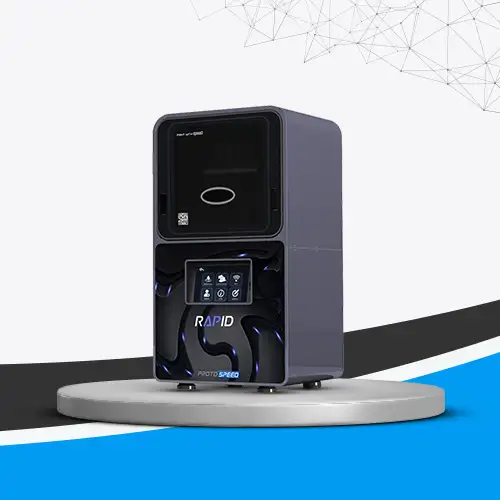
Contact Gesswein India for Demo
Gesswein India is the official distructor of Protospeed 3D Printers in India. Book your Demo Today
Contact Gesswein IndiaUNVEILING THE BRILLIANCE: AN EXTENSIVE LOOK AT INDIAN 3D PRINTERS FOR JEWELRY
The combination of technology and artistry is transforming the jewelry industry in India. Allow us to acquaint you with the realm of 3D printing jewelry, an innovative technique that is revolutionizing the production of intricate and personalized goods.
Jewelry 3D Printing's Evolution
Technology advancements in 3D printing have had a big impact on the jewelry industry. Before investing in pricey materials, 3D printing enabled designers to produce precise and detailed models through rapid prototyping. As technology developed, it was used for the creation of finished goods. These days, 3D printers can create extremely intricate jewelry, which is changing the Indian jewelry industry by making it feasible to create intricate patterns that were previously unattainable with conventional techniques.
Benefits of 3D Printing for Designing Jewelry
There are several benefits to 3D printing for jewelry design. With amazing accuracy, complex forms and patterns may be created thanks to technology. Designers can push the envelope of inventiveness by experimenting with intricate decorations and complex geometry. This accuracy makes it possible to realize creative ideas with a degree of accuracy that is unmatched by conventional techniques. Additionally, designers can save time and money by refining their concepts and making the required alterations before to final production with the aid of speedy prototype production.
Materials for Jewelry 3D Printing
The jewelry business may use 3D printing with a wide range of materials. In addition to speciality resins and other metals like titanium and stainless steel, precious metals like gold and silver can also be utilized. Because of their distinct qualities, each material may be used to create a variety of jewelry designs. For example, metal is typically utilised for finished components, although resins are frequently employed to create precise prototypes. Because materials are so versatile, designers can select the one that best suits their unique needs and aesthetic preferences.
Diverse Use Cases in the Jewelry Sector
The jewelry sector can benefit from a multitude of applications of 3D printing. With the use of this technology, producers and designers may produce one-of-a-kind, personalized goods including necklaces, earrings, engagement rings, and cutting-edge clothing. The capacity to create unique pieces that satisfy certain tastes is one of the biggest advantages. Custom engagement rings, for instance, can be made to precisely fit the vision of the buyer. Furthermore, jewelry is mass-produced via 3D printing, guaranteeing uniformity and quality in numerous pieces. 3D printing has the potential to revolutionize the jewelry business, as demonstrated by successful case studies from Indian jewelry enterprises.
Effect on Customary Handi-craftsmanship
Indian jewelry has a long history that combines contemporary technology with traditional creativity. Rather than taking the place of traditional workmanship, 3D printing is improving it. Craftspeople are using modern techniques to preserve the cultural significance and authenticity of traditional patterns. While embracing contemporary procedures, this blending of old and new approaches allows for the preservation of ancient abilities. Working together, traditional jewelers and 3D printing experts create one-of-a-kind items that pay tribute to the past while also looking to the future.
Jewelry Manufacturers' Adoption
A growing number of Indian jewelry producers are utilizing 3D printing technologies. This adoption speeds up the creation of prototypes, lowers expenses, and simplifies production procedures. Prominent Indian jewelry manufacturers have successfully incorporated 3D printing into their processes, improving the quality of their designs and the efficiency of their production. They can maintain their competitiveness in the global market by providing specialized, high-quality items thanks to technology.
Trends in Customization
3D-printed jewelry with personalization and customization is becoming more and more popular. Consumers are looking for distinctive items that showcase their preferences and aesthetics. Customized 3D-printed jewelry enterprises are growing as a result of this demand. These businesses provide a plethora of alternatives that enable clients to design genuinely unique custom pieces.
Problems and Solutions
There are various obstacles in the way of 3D printing's acceptance in the Indian jewelry industry. These include upfront expenses, the requirement for trained labor, and technical advancements. Nevertheless, with careful preparation and financial support, these challenges can be addressed. Investing in technology providers, forming alliances with them, and utilizing government assistance are some ways to lower expenses and promote the use of new technologies.
Education and Talent Acquisition
Jewelry 3D printing requires specialized skills. India offers a wide range of training programs, workshops, and courses to equip upcoming designers and technologists. Academic-industry collaborations aid in closing the skills gap and cultivating the talent required to propel the industry ahead. Through these activities, the workforce is guaranteed to possess the skills required to fully utilize 3D printing technology.
Upcoming Developments and Trends
India's 3D-printed jewelry industry appears to have a bright future. The use of sustainable materials, the incorporation of artificial intelligence (AI) into design procedures, and the possibility of localized, on-demand production are examples of emerging trends. The future of 3D-printed jewelry in India is exciting and full of possibilities as inventive entrepreneurs and imaginative initiatives continue to push the envelope.
Partnerships and Collaborations in Industry
Innovation is being driven and access to state-of-the-art technology is being expanded through partnerships between Indian jewelry makers and 3D printing technology providers. These collaborations encourage the sharing of knowledge and concepts, which results in the creation of novel goods and procedures. Effective partnerships have a big effect on the industry and make Indian jewelry more competitive worldwide.
International Comparisons
Opportunities for development and enhancement are shown when comparing the current state of 3D printing in India's jewelry industry with international trends. Businesses may pinpoint areas for improvement and capitalize on their advantages to compete globally by knowing how the Indian market compares to international norms.
In summary
The jewelry industry in India has undergone a paradigm shift in terms of manufacture, design, and customer expectations with the introduction of 3D printing technology. As the voyage continues, India discovers that it is in the midst of a transformative period in which tradition and technology come together to produce timeless masterpieces. India's 3D-printed jewelry industry has a bright future ahead of it, full of untapped potential.
11. Future Trends and Innovations:
Examine the prospects for 3D printing jewelry in India in the future. Talk about new trends that are coming up, such as using sustainable materials, integrating artificial intelligence (AI) into design processes, and the possibility of localized, on-demand production. Draw attention to creative initiatives or new businesses that are expanding the realm of the possible.
12. Industry Collaborations and Partnerships:
Examine joint ventures between Indian jewelry companies and 3D printing technology providers. Talk about the ways in which partnerships are promoting innovation, improving access to state-of-the-art technology, and aiding in the expansion of both sectors of the economy. Emphasize the effects of fruitful partnerships on the marketplace.
13. Case Studies:
Explore in-depth case studies that highlight particular initiatives, partnerships, or achievements in the 3D-printed jewelry sector in India. Emphasize the difficulties encountered, creative solutions used, and results obtained. Examples from real life offer insightful information and motivation.
14. Global Comparisons:
Examine the current condition of 3D printing in India's jewelry business in comparison to worldwide patterns. Examine the jewelry industry in India in relation to global norms and pinpoint opportunities for expansion and enhancement. Talk about how competitive Indian 3D-printed jewelry is on a global scale.
15. Conclusion:
In conclusion, the use of 3D printing technology by the Indian jewelry sector signifies a paradigm change in manufacturing, design, and customer expectations in addition to a technological one. As the voyage progresses, India finds itself at the front of a revolutionary age in which technology and tradition combine to produce enduring masterpieces.

